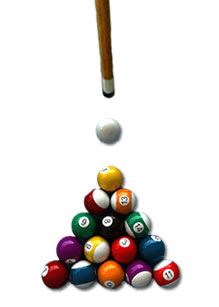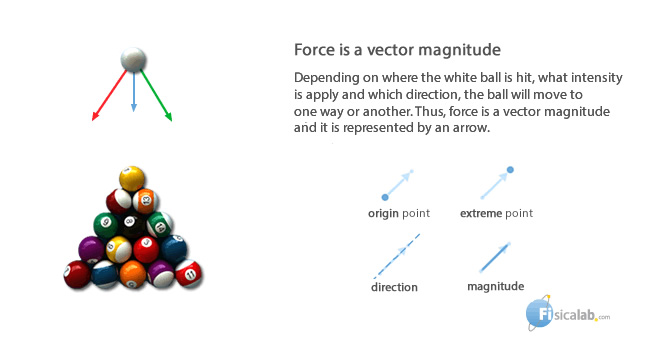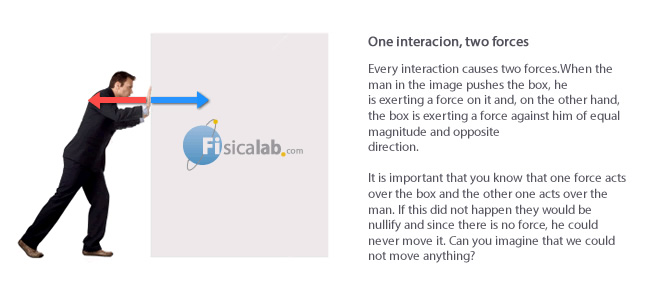In physics, a force is any interaction that, when unopposed, will change the motion of an object or its shape. In this section we are going to develop this idea which is, for instance, realated to the technology we use to travel by bike or car, but also, behind the everyday actions such as pushing the shopping trolley. In order to do this we will study:
- What forces are
- Their units of measure
- How we represent forces graphically
- How are they produced (causes) and what are their efects
Are you ready for it?
Concept of force
Imagine pushing a resting ball on a pool table with yor finger. Probably your intuition tells you that you are giving “strength” to the ball. In a more formal way we can say that we are applying a force to the ball. What happens next? Most likely our ball starts moving, but if it were a water balloon instead, it could happen that it deformed and our finger was "swallowed" by the balloon.
We define force as any interaction that, when unopposed, will change the motion of an object, or, will cause a deformation on it. A force is the interaction of a body with something external to it, as well as a vector characterised by magnitude (size) and direction.
The unit of the International System of measure is the Newton (N). One newton is the force required to cause a mass of one kilogram (kg) to accelerate at a rate of one meter per second squared (m/s2) in the absence of other force-producing effects.
Historically the study of bodies in motion and its cause has fascinated mankind since ancient times. Aristotle (284 – 322 a.C.), one of the most important wise men from Ancient Greek, he was one the forefathers of this study, his ideas were maintained during the whole Middle Ages. Then, Galileo Galilei (1564 – 1642) was able to describe motion mathematically (Principal of Relativity) but he did not analyse the causes of it. Years later Isaac Newton (1643 – 1727) was who, based on Galileo ́s ideas, define the causes of motion: forces.
Other units of measurement
Beside Newton, there are other units of measure less used:
- dyne (dyn). The standard centimeter-gram-second (CGS) unit of force, equal to the force that produces an acceleration of one centimeter per second per second (cm/s2) on a mass of one gram. 1 dyn = 10-5 N
- kilopond (kp) or kilogram – force (kgf). It is a gravitational metric unit of force. It is equal to the magnitude of the force exerted on one kilogram of mass in a 9.8m/s2 gravitational field (standard gravity, a conventional value approximating the average magnitude of gravity on Earth). 1 kp = 9.8 N
- poundal (pdl). A unit of force equal to that required to give a mass of one pound an acceleration of one foot per second per second. 1 pdl = 0.1382550 N
- pound - force (lbf). The pound-force is about equal to the gravitational force applied on a mass of one pound (0.45359237 kg.) on the surface of Earth. 1 lbf = 4,448222 N
- KIP. It equals 1000 pounds-force, used primarily by American architects and engineers to measure engineering loads. Although uncommon, it is occasionally also considered a unit of mass, equal to 1000 pounds: 1 KIP = 1000 lbf; 1 KIP = 4448,222 N
Representation of forces
Previously, we have defined force as a vector magnitude, so they are represented as vectors. Indeed, as you can observe on the next image, the direction of the force has to be into account in order to predict its effects.
Observe that one of the forces characteristics has been the initial point, also known as point of application. It is the point where force is applied, so the effects it produces , on a body may vary depending on it. In any case, on this level we will focus on punctual objects, so, applying a force to a body it is to apply it on its only point.
On the other hand, forces as vectors may be decomposed. This will let us, for instance, to observe the effects produced in space in each dimension (axis) separatly.
Effects of the force
Forces appear from interactions between bodies. Watch the next image.
Remember, every interaction leads to a couple of forces. This principle is known as law of action and reaction.
According to the distance of interaction between bodies we can distinguish two types:
- Interaction by contact. Forces emerged when two or more bodies are in contact. For example when there os a crash or when a door is pushed.
- Remote interaction. The bodies, even if they are not in contact, exert a strength on the rest of bodies. For instance, the force of attraction of a magnet towards something made of metal, or the gravity itself the Earth exerts on the moon and viceversa.
Furthermore, the effects produced by the forces can be summarised in two kinds:
Dynamics. They produce changes in the velocity (modulus and direction) of the body they act on. For instance, if the same strength on the shopping trolley is maintained and exerted in time, the speed of the trolley will be gradually increased. Newton ́s Law are particularly useful to understand the dynamic effects of the forces. On the other hand, we have to bear in mind that should the direction of the force exerted on a free body does not go throughout its centre of gravity, it produces a rotational motion (turn) and a driving motion (movement). This happens when a ball is kicked by the edge and not by the middle. For more information about this subject go to the subject dedicated to rigid solid
-
Elastic. They produce changes on the body structure they act on. For example, to forge a sword different kind os forces are exerted on a incandescent piece of steel.
Newton ́s second lawENLACE states that the acceleration of an object is dependent upon two variables - the net force acting upon the object and the mass of the object.




